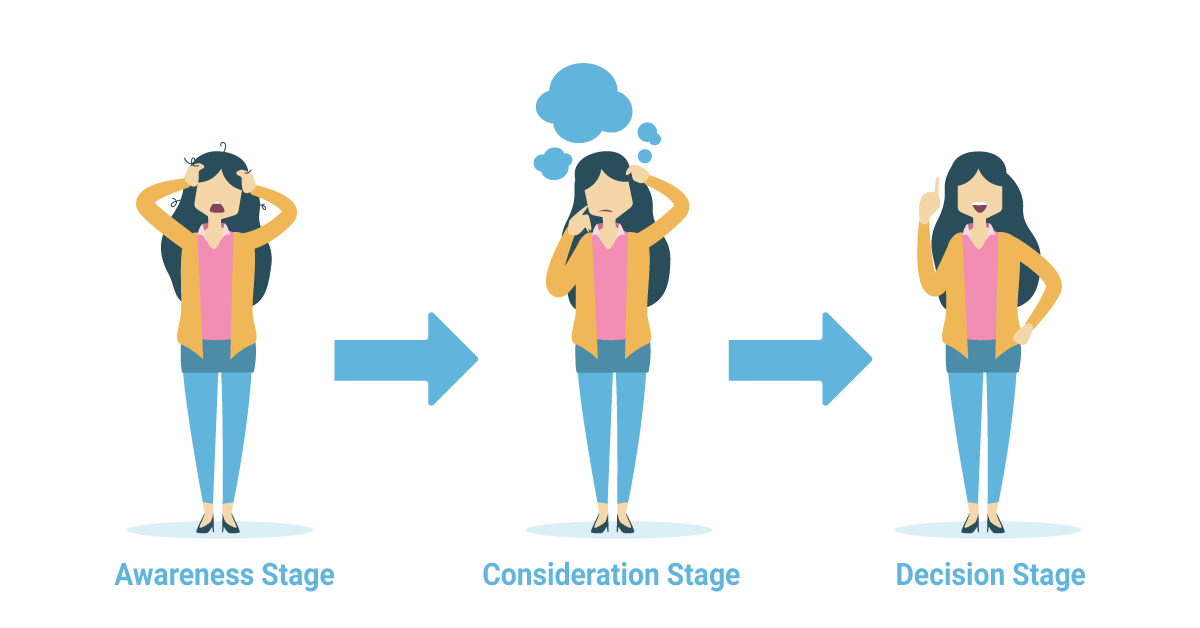The Hero's Journey. It’s central to all the greatest stories: Goldilocks going into the forest; Bilbo leaving The Shire; Odysseus going on his epic adventure around the Aegean Sea. Journeys are a part of the human condition.
So what about the buyer’s journey? If you’re a marketer, understanding the buyer’s journey is central to your content creation and subsequent conversions. If you don’t know where a prospect is on their journey to becoming a customer, how do you know if the content you’re giving them, the solutions you’re offering, and the language you’re using is going to capture their attention?
We hope this post clarifies each stage of the buyer’s journey for inbound marketers, and helps you target your content in a more streamlined, productive and effective way.
What is the buyer’s journey?
We are all on various stages of the buyer's journey. Every time you consider a new purchase - from where to eat for lunch, to which paint to use to decorate your bedroom - you're on the buyer's journey. Whether you're entering it at the Awareness Stage (Top of the Funnel), are choosing between options at the Consideration Stage (Middle of the Funnel) or are ready to hand over your cash at the Decision Stage (Bottom of the Funnel), you are somewhere along this timeline.
As HubSpot simply puts it:
‘The buyer's journey is the process buyers go through to become aware of, consider and evaluate, and decide to purchase a new product or service.’
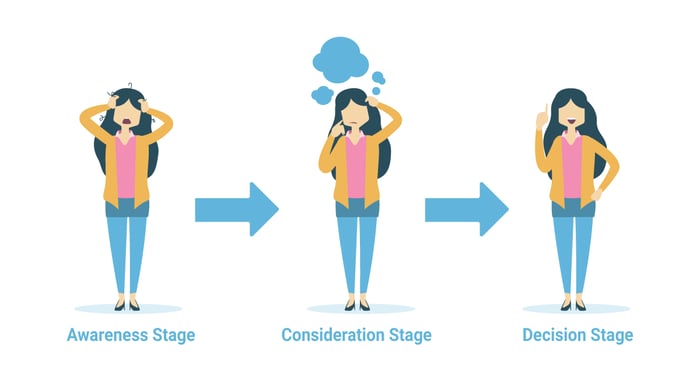 The journey consists of a three-step process (and the names for each stage fortunately follow in alphabetical order to help you memorise them!):
The journey consists of a three-step process (and the names for each stage fortunately follow in alphabetical order to help you memorise them!):
Stage 1: Awareness/Top of the Funnel (ToFu)
When the buyer realises they have a problem, they start to express their symptoms.
For example, you might feel like you’ve got an illness coming on and start to type your symptoms into Google. You don’t know what your issue is yet, just that you’ve got a tight chest, a dry cough and can’t stop sneezing.
At this stage, a buyer is keen to give a name to their problem, to answer the question "what is wrong with me?" It’s only once they have this knowledge that they can move onto the next stage in their journey.
Stage 2: Consideration/Middle of the Funnel (MoFu)
Once the buyer defines their problem, they can begin researching options to help them solve it.
For example, they’ve found out that it sounds like they’ve got sinusitis, caused by hay fever. They have the reassurance of giving a name to their problem, but don’t yet know how to fix it.
At this stage, their research turns from identifying the problem, to considering all of the available approaches for resolving the issue – in this case, the different medications, herbal remedies and lifestyle choices the buyer could make to avoid hay fever symptoms.
Stage 3: Decision/Bottom of the Funnel (BoFu)
Finally, the buyer chooses a solution. The buyer has decided upon their course of action and the solution that best fits their needs and tastes.
For example, the buyer has decided they need to take non-drowsy daily tablets, plus a nose spray.
At this stage, they know the product they’re after; the buyer now needs to whittle down a list of providers based on things like cost, speed of recovery, side effects etc. until they settle on their final product or brand.
In order to cover every possible buyer, you need to have content which directly aligns with these three stages in the process.
A closer look: The Awareness Stage
So what does this mean for the content you’re creating at the Awareness Stage? Here are a few more points about how to talk to your Awareness Stage buyers when creating content and interacting with them.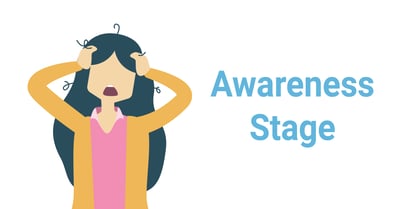
Awareness Stage buyer intentions:
- Buyers identify their challenges; they start to think things like: ‘X keeps happening and I’m getting annoyed’ or ‘I need to fix this’.
- They might identify an opportunity they want to pursue, for example – ‘My neighbour is getting a house extension, maybe I should get one’ too.’
- They decide whether or not the goal should be a priority; is this a problem which is affecting their life in a negative way daily, or can they live with it for a while?
Questions you need to consider:
- How do these buyers describe their goals or challenges? Are they frustrated? Angry? Upset? Hopeful? Excited? Confused?
- Which educational routes do buyers pursue, ahead of speaking to you – how do they try to fix their problems by themselves first?
- What will happen if the buyer doesn’t find a solution? Will the problem fix itself, stay the same or get worse?
- What are the most common misconceptions buyers have about addressing their problem?
- How do buyers decide how urgent a solution is for their problem?
How to create content for these customers:
- Your content should highlight their symptoms so they can identify them: for example, ‘Exercising, but still can’t lose weight? Maybe you need X’. If you write content that talks about the difficult challenges lots of people face – making these Awareness Stage buyers nod their head throughout your content – they’ll have a better awareness of what their problem is.
- Help your buyer summarise their problem in a simple sentence: ‘I want to lose weight and get fitter, without more effort than I’m already putting in.’
- Your aim is to move them along to the next stage in their journey: the Consideration Stage. If they can articulate their challenge, they’re one step closer to identifying you as a solution to their problem.
- Content formats need to be short – at this stage they are likely to be experiencing a lot of frustration so want quick, simple answers.
Examples could be:
- Short white papers which use facts and research to back up your points.
- A checklist – if they can tick off eight out of nine symptoms, you’ll have helped them identify what their problem is. There’s something reassuring about a list!
- Blog posts are a failsafe option at every stage of the Buyer’s Journey. A chatty, helpful and educational post can really help a buyer home in on their issues.
During the Awareness Stage, you need to establish your brand as a reliable source of information to the buyer. If you create a gated lead magnet to help them – something of real value which will help them learn more about their situation – your business can immediately follow up their email submission with information that will nurture them towards the next stage of the Buyer’s Journey.
Top tip: Don’t even think about mentioning your brand and solutions in your content for this stage – it’ll seem way too pushy for customers who haven’t even fully identified their problem yet. This content needs to focus on pain points and giving a name to their concerns.
A closer look: The Consideration Stage
A buyer may come to you already at the consideration stage: they know their problem and are now researching the various solutions. Your content focus will change accordingly.
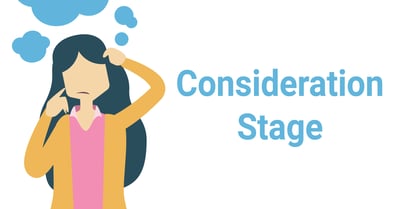
Consideration Stage buyer intentions:
- By now, buyers have clearly defined their goal or challenge: they have a name for their problem, for example: hay fever.
- The customer is committed to addressing this issue and has decided they can’t go on living with the problem: they need a solution.
- They are evaluating their options. They will be looking for a pool of solutions, before slimming them down in the Decision Stage.
Questions you need to consider:
- Which categories of solutions do your buyers investigate? For example, if they want to lose weight, are they after an exercise, diet, behavioural or pharmaceutical solution?
- How do customers educate themselves on these categories of solutions? Maybe exercise plans are best communicated in videos, whereas the diet solutions are mostly available in a written checklist/calendar format.
- What are the benefits and limitations of each category, according to the buyer? Make a list – put the pros and cons into columns.
- How do buyers decide which category solution is right for them? Does it come down to money? Convenience? Time? How expert the solution appears to be? Testimonials and examples?
How to create content for these customers:
- Customer testimonials – when a customer is considering a range of options, recommendations will resonate.
- Video content works well here: in a sea of blog posts, your buyer will appreciate an easy-to-watch summative video.
- As the person is closer to becoming a buyer now, try more interactive formats, such as live webinars and demos as they get ready to start making some choices. In the Awareness Stage these would be way too pushy, but by now prospects should be more open to engaging with your brand.
- Give them content that helps them narrow down what they want - and what they don't. By presenting them with a range of options, they’ll soon get a clearer sense of their must-haves.
- Interactive tools like chatbots offer customers a fun way to discover more about what they’re after – offering a series of yes/no questions with a solution based on their answers is a great way to move a customer along on their journey.
Top tip: When writing content for the Consideration Stage, don’t be too me, me, me. This isn’t an opportunity to start ramming your brand down the buyer’s throat and wax lyrical about all the fantastic things your product does. It’s still too early for that: if you start talking about your product in depth, you’re going to scare them away.
What you can do is offer your business’ category as ONE of the solutions, as well as mentioning a load of other options. Keep the net as wide as possible to help them; don’t push them down one route before they’re ready.
A closer look: The Decision Stage
You might have moved your buyer along the buyer's journey, or a new buyer might come to you at the decision stage. When a prospect is at this point, you can start talking to them a lot more directly about your product.
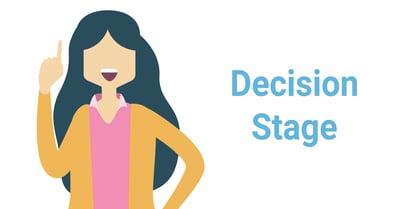
Decision Stage buyer intentions:
- Buyers have already decided on a solution category. For example, their lawn is getting too much for them to manage, so instead of hiring a gardener to keep it for them or paving the lawn over with slabs, they’ve decided to buy an automated lawnmower.
- If asked, they could write a pros and cons list about each of the specific offerings they’ve considered
- They might already be able to name some brands, but they still need to find the specific model or offering for them.
Questions you need to consider:
- What criteria do buyers use to evaluate their research options? Price? Delivery time? Ease of use? Size? Time needed to see results?
- How does your offering compare to alternatives? What is your USP?
- What concerns might they have about your product or service?
- Are they the decision maker? If not, who at their business needs to be involved?
- Do your buyers want to try the product before they purchase it? How much input from you are they expecting?
- Do buyers need extra help, such as implementation plans or training strategies, or can they start once they buy your product?
How to create content for these customers:
- You want to persuade the buyer your company is best suited to handling their issues. Therefore, you need to put yourself in the customer's shoes and consider all the possible excuses they could pose in resistance to your product: then address these points head-on.
- In our example, the buyer has decided to purchase an automated lawnmower. Their attention now focuses on purchasing the right model and brand for them. Discuss all the points that make your product faster, more cost effective, energy effective etc – really focus on drawing out those benefits.
Examples could be:
- Highlighting your product's best points could come in the form of a free demo or trial: these are persuasive methods.
- You might choose to create charts or infographics which highlight the competitive advantage you have over other products.
- You're so close to a purchase being made that it could be worth bringing out promotional techniques, such as limited-time discounts or coupons.
Top tip: In this stage you can be a lot more direct. Name your brand, name your models or packages, feature quotes from influential people at your business, and include plenty of links to product pages for customers to find out more: this isn't the time to be a wallflower!
Because a buyer could be joining you at any stage of the buyer’s journey – or you could be moving them along to the next one with each piece of content – it’s essential you have inbound marketing campaigns that cater to every phase of the buyer's journey.
If all your content is Decision Stage, you'll come off far too forcefully and scare away potential customers. Likewise, if all you do is talk about pain-led issues and never mention the solutions, your content will seem too vague to ever encourage a purchase. Ensuring your blog has a balance of articles – targeted at each of your buyer personas – will ensure a joined up process and greater sales success.
.png)
Lucy Seymour
Stay Updated with Our Latest Insights
Get expert HubSpot tips and integration strategies delivered to your inbox.
